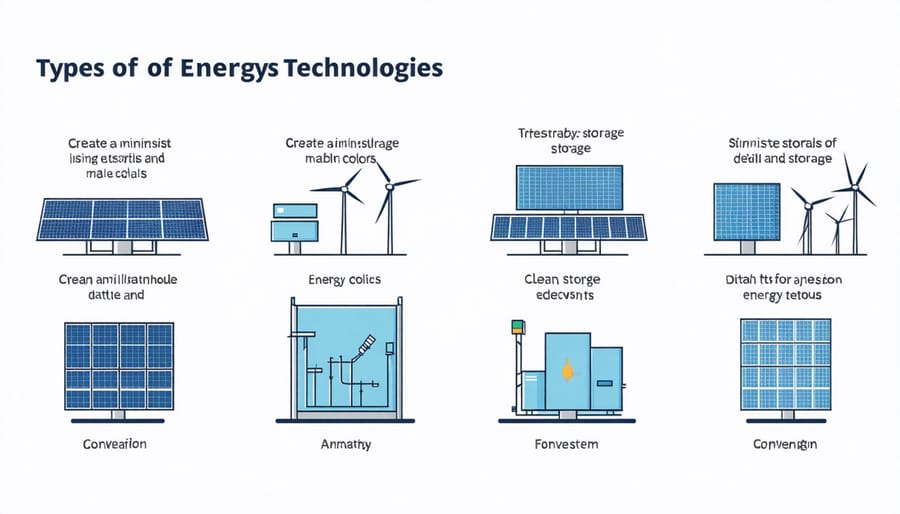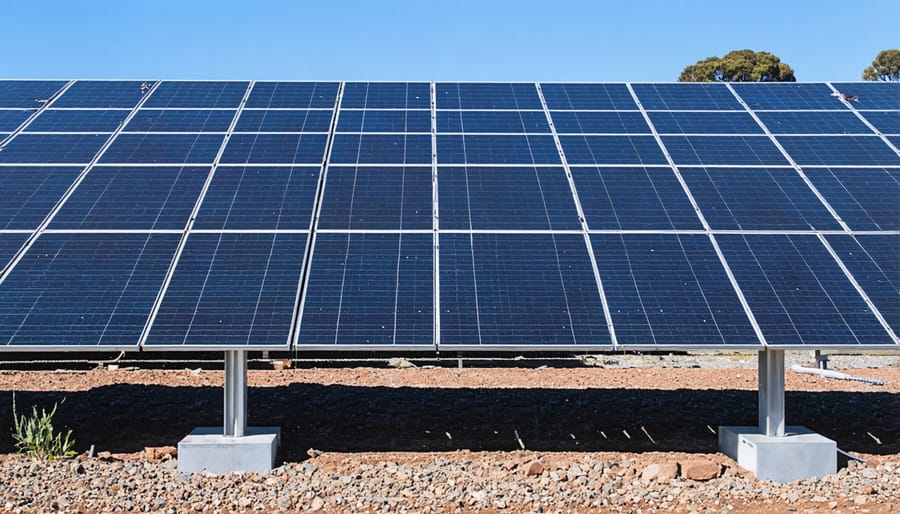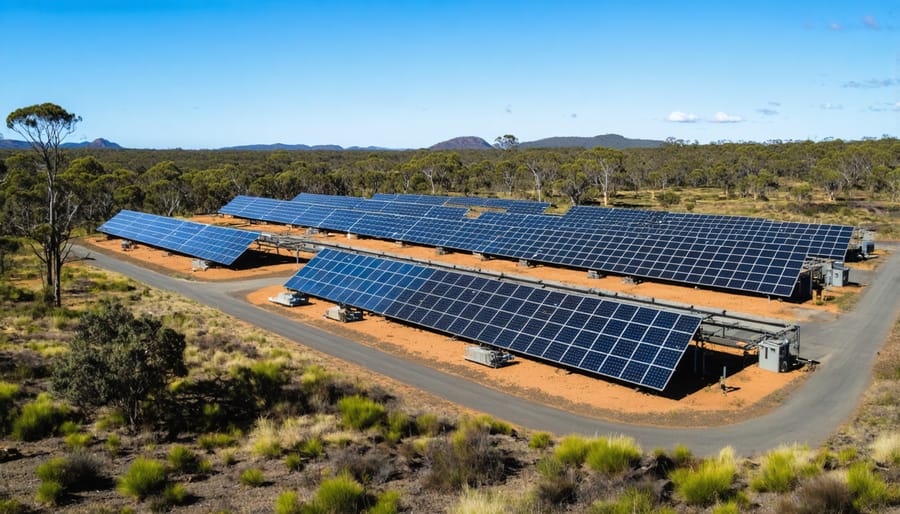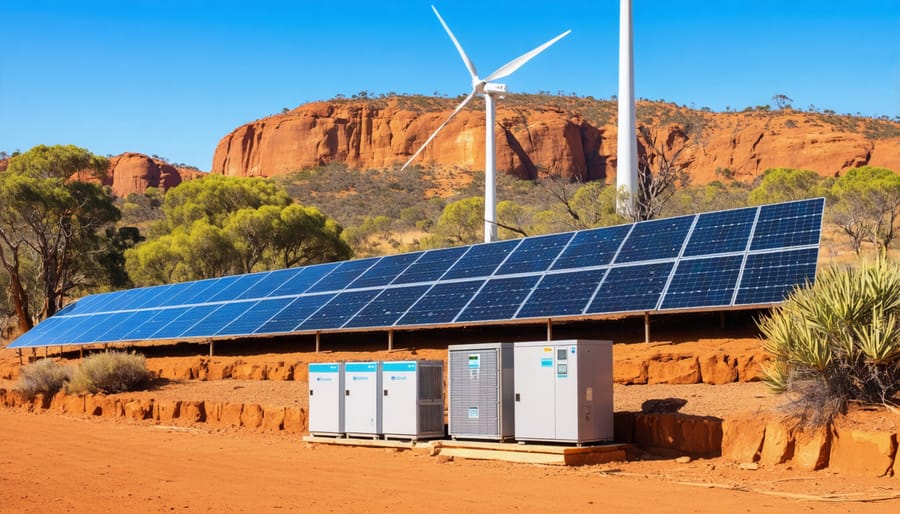Imagine powering your home completely independent of the grid, drawing energy from the sun during the day and seamlessly transitioning to stored power at night. Off-grid energy storage systems are revolutionizing how Australians achieve energy independence, particularly in remote locations where traditional power infrastructure is costly or impractical.
From outback stations to coastal eco-homes, these systems are transforming the way we think about energy security and sustainability. Modern storage solutions combine advanced battery technology, smart management systems, and renewable energy sources to create reliable, self-sufficient power networks that operate year-round, even in Australia’s challenging climate conditions.
As energy costs continue to rise and climate concerns grow, off-grid storage represents more than just an alternative to traditional power—it’s becoming a practical necessity for many Australians seeking energy autonomy. Whether you’re planning a remote property development, looking to reduce your carbon footprint, or preparing for increasing grid instability, understanding these systems is crucial for making informed decisions about your energy future.
This comprehensive guide explores the latest storage technologies, from lithium-ion batteries to emerging alternatives, helping you navigate the path to energy independence with confidence and clarity.
Why Off-Grid Energy Storage Matters for Australian Sustainability
Environmental Impact and Carbon Reduction
Off-grid energy storage systems play a pivotal role in reducing our environmental footprint while accelerating the transition to renewable energy. By enabling the efficient capture and use of solar and wind power, these systems help eliminate the need for diesel generators and other fossil fuel-based backup power sources, significantly cutting carbon emissions.
A typical household switching to an off-grid storage system can prevent approximately 4-6 tonnes of CO2 emissions annually – equivalent to taking a car off the road for a year. In remote Australian communities, where diesel generators have traditionally been the go-to power source, the adoption of storage solutions paired with solar panels has dramatically reduced both air pollution and noise pollution.
These systems also support the broader renewable energy ecosystem by helping to balance supply and demand. During peak solar production hours, excess energy is stored rather than wasted, creating a more efficient and sustainable energy cycle. This storage capability has proven particularly valuable in Australia’s outback regions, where it has enabled communities to maintain a reliable power supply while significantly reducing their carbon footprint.
Looking ahead, off-grid storage systems are becoming increasingly crucial in our fight against climate change, offering a practical solution for sustainable living without compromising on reliability or performance.
Energy Independence and Rural Applications
For rural Australian properties and agricultural operations, off-grid energy storage systems represent more than just an environmental choice – they’re a pathway to energy independence and operational reliability. Remote farms and stations often face challenges with grid connectivity and reliability, making self-sufficient power systems particularly valuable. These storage solutions, combined with effective renewable energy forecasting, enable farmers to maintain consistent power for crucial operations like irrigation systems, cold storage facilities, and livestock management equipment.
The benefits extend beyond basic power provision. Agricultural businesses can significantly reduce their operational costs by storing excess energy generated during peak production periods and using it during high-demand times. This approach proves especially valuable during harvest seasons when energy demands spike. For remote homesteads, these systems provide peace of mind, ensuring essential services remain operational regardless of grid outages or extreme weather events.
Many rural properties are now implementing hybrid systems that combine solar arrays with battery storage and backup generators, creating robust energy networks that support both domestic and commercial needs. This self-reliance not only improves operational efficiency but also increases property values and supports sustainable farming practices.

Popular Off-Grid Storage Technologies

Battery Storage Systems
Modern battery storage solutions form the backbone of reliable off-grid energy systems, offering various options to suit different needs and budgets. Lithium-ion batteries have emerged as the leading choice for many Australians, thanks to their impressive efficiency rates of up to 95%, longer lifespan, and minimal maintenance requirements. These systems can easily handle daily charging cycles and maintain consistent performance in our challenging climate.
Lead-acid batteries, while more traditional, continue to provide a cost-effective option for those getting started with off-grid storage. Though they require more maintenance and have a shorter lifespan than their lithium counterparts, their lower upfront cost and proven reliability make them a practical choice for many rural properties and smaller installations.
Recent innovations have introduced advanced battery chemistries like lithium iron phosphate (LiFePO4), which offers enhanced safety features and superior thermal stability – crucial for Australia’s extreme temperatures. These batteries typically last 10-15 years and can withstand more charging cycles than traditional options.
The integration of smart battery management systems has revolutionized how we monitor and maintain these storage solutions. Modern systems can automatically regulate charging patterns, protect against overcharging, and even provide real-time performance data through smartphone apps. This technology has made it easier than ever for homeowners to maximize their energy independence while ensuring optimal battery performance.
When selecting a battery system, consider factors like daily energy consumption, peak power requirements, and available space. Many Aussie households find that a 10-15kWh system provides sufficient storage for typical daily needs, though requirements vary based on lifestyle and energy usage patterns.
Mechanical Storage Solutions
When it comes to storing energy without batteries, mechanical storage solutions offer robust and time-tested alternatives. Pumped hydro storage, Australia’s most established mechanical storage system, works like a natural battery using two water reservoirs at different heights. During off-peak periods, excess energy pumps water to the upper reservoir, and when power is needed, water flows down through turbines, generating electricity.
The Snowy Mountains Hydro Scheme stands as a prime example, demonstrating how pumped hydro can support off-grid systems on both large and small scales. For property owners with suitable terrain, micro-pumped hydro systems can provide reliable storage solutions, particularly in hilly regions along the Great Dividing Range.
Compressed air energy storage (CAES) offers another mechanical solution gaining traction in the Australian market. This system uses surplus energy to compress air into sealed underground caverns or specially designed tanks. When power is needed, the compressed air is released through turbines to generate electricity. While traditionally used in large-scale applications, innovative companies are now developing smaller, modular CAES units suitable for off-grid properties and remote communities.
Both these mechanical storage solutions boast impressive longevity, with systems capable of operating effectively for 50+ years with proper maintenance. They’re particularly valuable in harsh Australian conditions where traditional battery storage might struggle with extreme temperatures. Unlike chemical batteries, these mechanical systems don’t degrade significantly over time, making them cost-effective long-term investments for off-grid energy storage.
For remote mining operations and isolated communities, these mechanical solutions offer reliable alternatives to conventional battery storage, especially when natural geography can be leveraged to advantage.
Thermal Energy Storage
Thermal energy storage offers a clever way to store surplus energy as heat, making it an increasingly popular choice for off-grid systems in Australia. This method works brilliantly in our climate, where managing temperature extremes is a daily challenge.
One of the most straightforward approaches is using molten salt storage, where excess energy heats large quantities of salt to temperatures exceeding 500°C. This stored heat can later generate steam for electricity or provide direct heating when needed. Several remote mining operations in Western Australia have already embraced this technology, significantly reducing their reliance on diesel generators.
Phase change materials (PCMs) represent another innovative solution gaining traction. These materials store and release energy through the process of changing from solid to liquid and back again. Think of it like a reusable ice pack, but on a much larger scale and operating at different temperatures. PCMs are particularly effective for maintaining comfortable temperatures in off-grid homes and small businesses, requiring minimal maintenance once installed.
Hot water storage systems, a tried-and-true thermal storage method, continue to prove their worth in Australian conditions. Modern systems can integrate seamlessly with solar thermal collectors or excess electricity from solar panels, storing energy in well-insulated tanks for later use. For many off-grid homesteads in Queensland and Northern Territory, these systems provide reliable hot water while reducing overall energy demands. Learn more about how solar hot water systems are a win-win in Australia.
Underground thermal energy storage (UTES) is emerging as a game-changer for larger off-grid applications. By utilizing the earth’s natural insulating properties, UTES systems can store heat or cold for extended periods with minimal losses. Several eco-tourism resorts in remote locations have successfully implemented this technology, maintaining year-round comfort while staying true to their sustainability goals.
The beauty of thermal storage lies in its simplicity and reliability. Unlike some other storage technologies, thermal solutions often require less complex maintenance and can last for decades with proper care.
Real-World Success Stories
Remote Farm Operations
In the heart of rural Australia, farmers are increasingly turning to off-grid energy storage systems to power their remote operations sustainably. These systems have become game-changers for properties far from traditional power infrastructure, enabling renewable energy for farms to become a practical reality.
The Thompson family’s dairy farm in Victoria showcases how effective these systems can be. Their 50kWh battery storage system, coupled with solar panels, powers their entire milking operation, cold storage facilities, and irrigation systems. This setup has not only slashed their operational costs but also ensured uninterrupted power supply during critical farming processes.
In Queensland’s outback, the Wilson Station has implemented a hybrid system combining lithium-ion batteries with a small backup generator. This configuration maintains reliable power for their wool shed operations, staff quarters, and smart farming equipment. The system’s smart energy management features automatically prioritize stored energy usage during peak demand periods, particularly during shearing season.
These agricultural success stories demonstrate how off-grid storage solutions are perfectly suited to Australia’s farming sector. Modern systems can be scaled to match specific farm requirements, from small hobby farms to large commercial operations. The combination of battery storage with solar generation has proven particularly effective in managing the irregular power demands of agricultural equipment while maintaining consistent supply for everyday needs.

Off-Grid Communities
In the heart of the Northern Territory, the remote Indigenous community of Daly River stands as a shining example of off-grid success. Since 2019, this community has powered over 100 homes using a sophisticated solar and battery storage system, significantly reducing their reliance on diesel generators and cutting fuel costs by 50%.
The Flinders Island transformation tells another compelling story. This Bass Strait community revolutionised its power supply with a hybrid system combining solar, wind, and battery storage. The island now operates on 60-90% renewable energy throughout the year, proving that off-grid solutions can provide reliable power even in challenging maritime conditions.
Over in Western Australia, the Rottnest Island initiative showcases how tourist destinations can embrace sustainable power. Their integrated solar-wind-battery system not only powers the island’s facilities but also runs their desalination plant, providing fresh water to thousands of annual visitors.
Perhaps most inspiring is the story of Coober Pedy, where extreme desert conditions once made power supply challenging. Today, this opal mining town derives 70% of its electricity from renewable sources, supported by a robust battery storage system that ensures continuous power despite the harsh outback climate.
These communities demonstrate that with proper planning and modern storage technology, off-grid living isn’t just possible – it’s thriving in some of Australia’s most remote locations.
Implementation Guide and Best Practices
When implementing an off-grid energy storage system, careful planning and consideration of local conditions are essential for success. Start by conducting a thorough energy audit to determine your power requirements, including peak loads and daily consumption patterns. This information will help you right-size your system and avoid costly oversizing or undersizing issues.
For residential installations, lithium-ion batteries typically offer the best balance of cost, efficiency, and longevity. However, larger commercial energy storage systems might benefit from flow batteries or other industrial-scale solutions.
Consider your climate when positioning storage components. In Australia’s harsh conditions, ensure batteries are housed in temperature-controlled environments, ideally between 15-25°C. Install monitoring systems to track performance and maintain optimal charging cycles.
Redundancy is crucial – include backup power sources and consider a hybrid system combining different storage technologies. Regular maintenance schedules should include battery health checks, connection inspections, and system efficiency monitoring.
For best results, work with certified installers familiar with Australian standards and regulations. They can help navigate technical requirements and ensure compliance with local building codes. Remember to factor in future expansion needs when designing your system, as energy requirements often grow over time.
Keep detailed records of system performance and establish clear protocols for maintenance and emergency situations. This documentation proves invaluable for troubleshooting and optimization.
As we’ve explored throughout this article, off-grid energy storage systems represent a crucial stepping stone towards Australia’s sustainable energy future. These systems not only provide energy independence but also contribute significantly to reducing our carbon footprint. From battery technologies to thermal storage solutions, the options available today are more accessible and efficient than ever before.
By embracing these storage solutions, households and businesses across Australia can play a vital role in our nation’s renewable energy transition. The success stories we’ve shared demonstrate that going off-grid is not just a dream but a practical reality. Whether you’re in the outback or the suburbs, there’s an energy storage solution that can meet your needs.
Take the first step today by assessing your energy requirements and consulting with local renewable energy experts. Together, we can build a more resilient and sustainable energy future for all Australians. The technology is ready – the only question is, are you?

